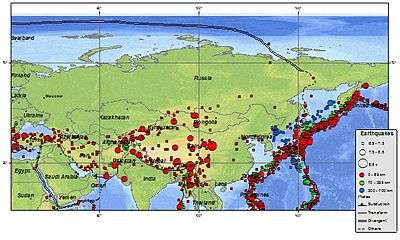Kamchatka earthquakes
Three earthquakes, which occurred off the coast of Kamchatka Peninsula in far eastern Russia in 1737, 1923 and 1952, were megathrust earthquakes and caused tsunamis. They occurred where the Pacific Plate subducts under the Okhotsk Plate at the Kuril-Kamchatka Trench. The depth of the trench at the point of the earthquakes is 7,000–7,500 m. Northern Kamchatka lies at the western end of the Bering fault, between the Pacific Plate and North American Plate,[1] or the Bering plate[2] There are many more earthquakes and tsunamis originating from Kamchatka, of which the most recent was the 1997 Kamchatka earthquake and tsunami originating near the Kronotsky Peninsula.

1737 earthquake
The epicentre of the 1737 earthquake was located at 52.5°N 159.5°E. This earthquake occurred at a depth of 40 km (25 miles). A magnitude of 8.3 Ms (9.0Mw) has been estimated.[3]
1923 earthquakes
On February 4, 1923, an estimated magnitude 8.3–8.5 Mw earthquake with an approximate location of 54.0°N 161.0°E triggered an 8-meter (26-foot) tsunami that caused considerable damage in Kamchatka, with a number of reported deaths.[4][5] The tsunami was still 6 meters (20 feet) high when it reached Hawaii, causing at least one fatality.[4] There was another earthquake and tsunami in April 1923, which caused locally high tsunami runup near Ust' Kamchatsk, leaving a deposit studied by Minoura and others.[6]
1952 earthquake
The main earthquake struck at 16:58 GMT (04:58 local time) on November 4, 1952. Initially assigned a magnitude of 8.2, the quake was revised to 9.0 Mw in later years.[7] A large tsunami resulted,[8] causing destruction and loss of life around the Kamchatka peninsula and the Kuril Islands. Hawaii was also struck, with estimated damage of up to US$1 million and livestock losses, but no human casualties were recorded. Japan reported no casualties or damage. The tsunami reached as far as Alaska, Chile, and New Zealand.[4][9]
The hypocentre was located at 52.75°N 159.5°E, at a depth of 30 km (18.6 miles). The length of the subduction zone fracture was 600 km (373 miles). Aftershocks were recorded in an area of approximately 247,000 km2 (90,367 square miles), at depths of between 40 and 60 km (25 and 37 miles).[10][11] A recent analysis of the tsunami runup distribution based on historical and geological records give some indication as to the slip distribution of the rupture.[12]
References
- Kamchatka: Edge of the Plate Archived 2007-08-07 at the Wayback Machine
- Pedoja, K., Bourgeois, J., Pinegina, T., Higman, B., 2006. Does Kamchatka belong to North America? An extruding Okhotsk block revealed by coastal neotectonics of the Ozernoi Peninsula, Kamchatka, Russia, Geology, v. 34(5), pp. 353–356.
- "Page on tsunami associated with event from West Coast and Alaska warning center". Archived from the original on 2009-05-15. Retrieved 2009-05-20.
- Tsunami Laboratory, Novosibirsk, Russia
- Largest Earthquakes in the World Since 1900 Archived 2010-11-07 at the Wayback Machine United States Geological Survey
- Minoura, K., Gusiakov, V.G., Kurbatov, A., Takeuti, S., Svendsen, J.I., Bondevik, S., and Oda, T., 1996, Tsunami sedimentation associated with the 1923 Kamchatka earthquake. Sedimentary Geology, v. 106, pp. 145–154.
- Historic Earthquakes Archived 2009-08-25 at the Wayback Machine It was also said to be magnitude 9.2.
- MacInnes,B.T., Weiss, R., Bourgeois, J., Pinegina, T.K., 2010. Slip distribution of the 1952 Kamchatka great earthquake based on near-field tsunami deposits and historical records. Bull. Seismol. Soc. America, v. 100(4), pp. 1695–1709.
- Bureau of Meteorology: Tsunami Information
- The aftershock sequence of the Kamchatka earthquake of November 4, 1952 - BÅTH and BENIOFF 48 (1): 1 - Bulletin of the Seismological Society of America
- Three Kamchatka earthquakes - STAUDER 50 (3): 347 - Bulletin of the Seismological Society of America
- MacInnes et al., 2010, see above.
External links
- (in Russian) Землетрясения на Командорских островах.
- (in Russian) Землетрясения на Камчатке: информация, впечатления жетелей Камчатки.